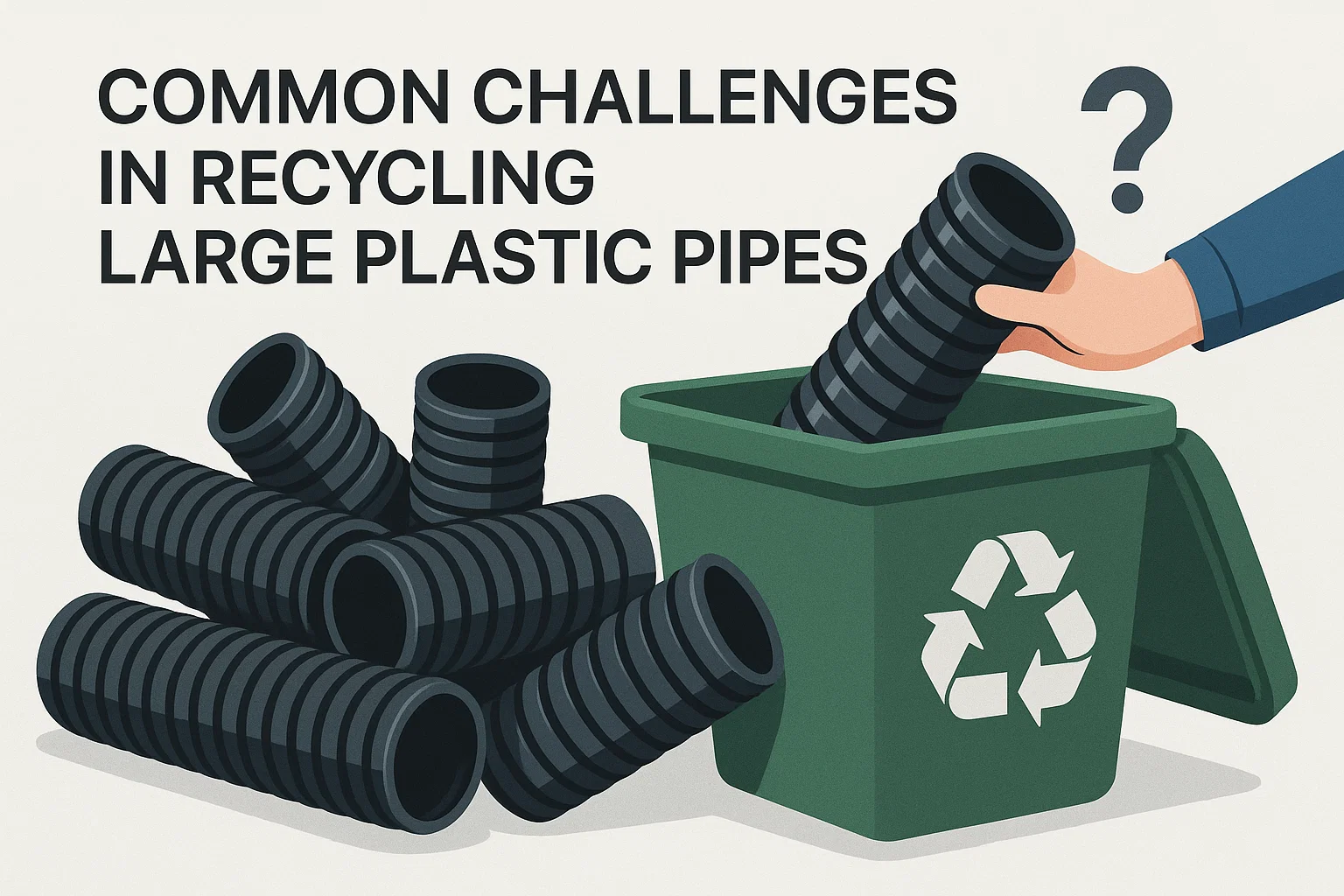The Ultimate Guide to HDPE Pipe Recycling: From Waste Stream to Revenue Stream
Large-diameter HDPE and other plastic pipes are the unsung heroes of modern infrastructure. They are tough, long-lasting, and reliable. But when they reach the end of their service life or become scrap during construction, they transform from an asset into a significant logistical nightmare.
For project managers, recycling facility operators, and construction site supervisors, disposing of these bulky items presents a unique set of challenges that can strain budgets, stall operations, and create safety hazards.
However, these challenges are not insurmountable. With the right strategy and the right technology, what seems like a costly problem can be turned into a streamlined, and even profitable, part of your operation. Here are the five most common challenges in large-diameter plastic pipe disposal and, more importantly, how to solve them.
Challenge 1: Exorbitant Transportation and Storage Costs
The Challenge: A 40-foot-long, 24-inch-diameter pipe is mostly empty space. Transporting whole pipes means you are paying to ship air. A single truck can only carry a few pipes at a time, making transportation from a job site to a disposal or recycling facility incredibly inefficient and expensive. Furthermore, storing these pipes requires a massive footprint in your yard, consuming valuable space that could be used for other operations.
The Solution: On-Site Volume Reduction. The most effective way to slash these costs is to reduce the volume of the material before it ever gets on a truck. By processing the pipes on-site or at a local consolidation point, you can transform bulky, hollow pipes into a dense, compact, and easily transportable shredded material. A single truckload of shredded plastic can contain the equivalent of dozens of truckloads of whole pipes, dramatically reducing your logistics overhead and freeing up valuable yard space.
Challenge 2: The Sheer Toughness of the Material
The Challenge: HDPE is engineered to be tough, flexible, and resistant to impact. This is great for its primary application, but a nightmare for disposal. Attempting to process these pipes with the wrong equipment, such as a high-speed granulator, will result in failure. The material will likely bounce off the blades or wrap around the rotor, causing costly downtime and equipment damage. Manual cutting with saws is dangerously slow, labor-intensive, and poses significant safety risks to personnel.
The Solution: High-Torque, Low-Speed Shredding. This is a problem of physics, and it requires the right tool. Unlike granulators that rely on speed and impact, a purpose-built HDPE pipe shredder uses immense torque and low-speed, high-pressure shearing action. Its powerful blades grab the pipe and methodically cut it into uniform strips or chips, regardless of wall thickness or material elasticity. This is the only reliable and efficient method for the primary size reduction of tough, large-format plastics.
Challenge 3: Contamination and Purity Issues
The Challenge: Pipes that have been in service, especially underground, are rarely clean. They arrive contaminated with dirt, rocks, sand, and other debris. Feeding this contaminated material directly into certain types of processing equipment can cause severe abrasive wear. More importantly, this contamination drastically lowers the value of the plastic, making it difficult to sell to reclaimers. Cleaning the interior of a long, intact pipe is practically impossible.
The Solution: Shred First, then Wash. A robust industrial shredder is designed to handle a moderate level of contamination without failing. The shredding process itself acts as a form of pre-cleaning, shaking much of the dirt and debris loose. Once the pipe is reduced to smaller chips, it can be efficiently washed and purified through systems like float-sink tanks, where the lighter plastic is easily separated from heavier contaminants. This “shred-then-wash” sequence is the key to producing a high-purity, high-value final product.
Challenge 4: Inefficient Feeding and Processing Bottlenecks
The Challenge: How do you create a consistent, automated recycling line when your input material is a 40-foot-long pipe? You can’t. Feeding whole pipes is an awkward, manual, batch-based process that creates huge bottlenecks in any downstream operation (like washing or pelletizing). The workflow is constantly interrupted, and machinery sits idle while operators wrestle with the next massive pipe.
The Solution: Creating a Uniform Feedstock. Shredding solves this fundamental operational problem by converting an inconsistent, bulky input into a consistent, free-flowing feedstock. The resulting plastic chips can be easily handled by conveyors, hoppers, and other automated systems, allowing you to run a continuous, efficient processing line. This transforms the entire operation from a clumsy, stop-and-start job into a smooth, industrial process.
Challenge 5: Rising Landfill Costs and Environmental Pressure
The Challenge: The “do nothing” option of sending plastic waste to a landfill is becoming less viable every day. Landfill tipping fees, especially for bulky items, are continuously rising. Furthermore, growing environmental regulations and corporate sustainability mandates (ESG goals) are placing immense pressure on companies to divert plastic from landfills. Simply burying this valuable resource is no longer a responsible or cost-effective option.
The Solution: Turning a Liability into a Revenue-Generating Asset. The ultimate solution is to reframe the problem. These pipes are not waste; they are a resource. By investing in a size reduction system, you are not just buying a piece of equipment; you are unlocking the value trapped inside the plastic. The clean, shredded HDPE you produce is a sought-after raw material in the manufacturing industry. The initial investment in a shredder can be quickly offset by eliminating landfill fees and creating a new, consistent revenue stream.
Conclusion: The Right Technology Turns Challenges into Opportunities
The disposal of large-diameter plastic pipes doesn’t have to be a source of frustration and high costs. By systematically addressing the core issues of size, toughness, contamination, and processing inefficiency with the right technology, you can master the challenge.
A high-torque industrial shredder is the cornerstone of this solution, acting as the gateway that turns a logistical problem into a valuable resource. It is the first and most critical step in building a safe, efficient, and profitable plastic recycling operation.
Facing these challenges at your site? Contact our engineers to discuss how a tailored shredding solution can transform your plastic waste stream.



